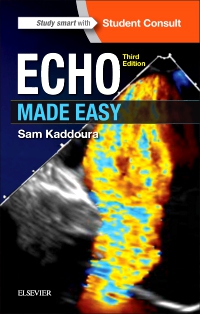
Echo Made Easy, 3rd Edition
Paperback

-
- This highly-praised book is a simple guide to a difficult subject, written in a conversational and accessible style. It is essential reading for anyone wishing to learn about echo – doctors in training, cardiac technicians, medical students etc.
- It provides full practical coverage of the clinical aspects of heart disease
- It will be of great use to those experienced in echo both as a refresher and an accessible reference source
-
Acknowledgements
Abbreviations
1 What is echo?
1.1 Basic notions
1.2 Viewing the heart
1.3 Echo techniques
1.4 Normal echo
1.5 Who should have an echo?
1.6 Murmurs
2 Valves
2.1 Mitral valve
2.2 Aortic valve
2.3 Tricuspid valve
2.4 Pulmonary valve
3 Doppler – velocities and pressures
3.1 Special uses of Doppler
3.2 Continuity equation
4 Heart failure, myocardium and pericardium
4.1 Heart failure
4.2 Assessment of LV systolic function
4.3 Coronary artery disease
4.4 Cardiomyopathies and myocarditis
4.5 Diastolic function
4.6 Right heart and lungs
4.7 Long-axis function
4.8 Pericardial disease
4.9 Device therapy for heart failure – cardiac resynchronization therapy
5 Transoesophageal, 3-D and stress echo and other echo techniques
5.1 Transoesophageal echo
5.2 Stress echo
5.3 Contrast echo
5.4 Three-dimensional (3-D) echo
5.5 Echo in special hospital settings
6 Cardiac masses, infection, congenital abnormalities and aorta
6.1 Cardiac masses
6.2 Infection
6.3 Artificial (prosthetic) valves
6.4 Congenital abnormalities
6.5 Aorta
7 Special situations and conditions
7.1 Pregnancy
7.2 Rhythm disturbances
7.3 Stroke, TIA and thromboembolism
7.4 Hypertension and LVH
7.5 Breathlessness and peripheral oedema
7.6 Screening and follow-up echo
7.7 Advanced age
7.8 Echo abnormalities in some systemic diseases and conditions
7.9 Individuals with cancer
8 Performing and reporting an echo
Conclusions
Further reading
